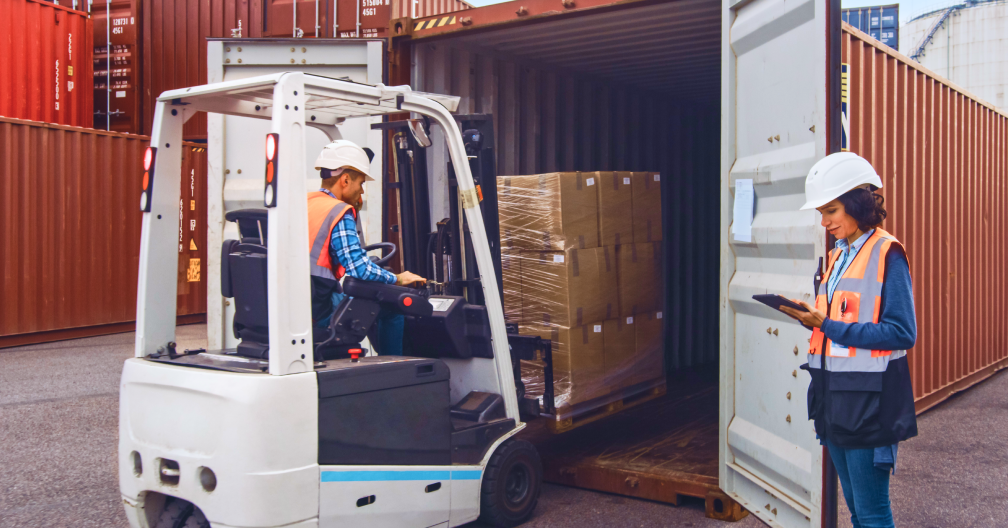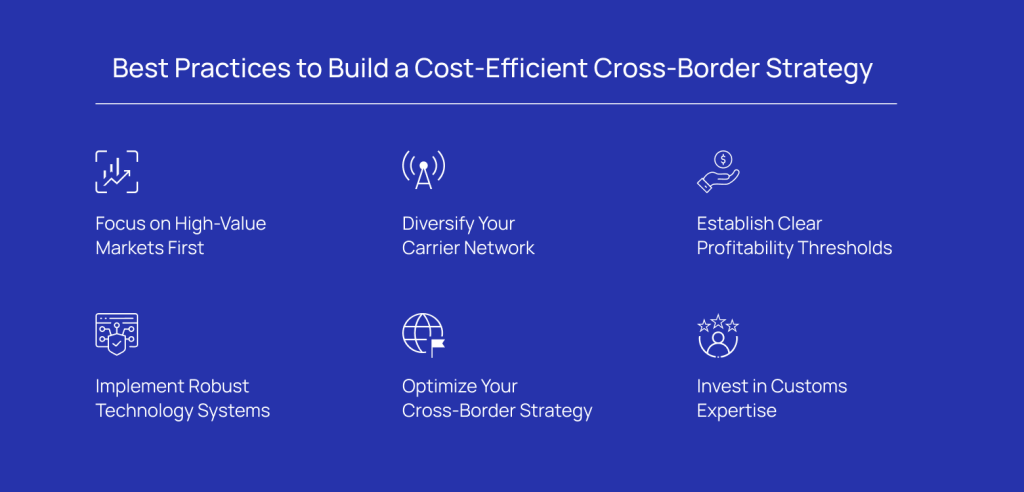International Shipping: Designing a Profit-Resilient Strategy for Enterprise E-commerce
Blogs
As global e-commerce accelerates towards a projected $6.8 trillion by 2028 [1], brands are under pressure to expand their footprint in more markets.
The opportunities are massive–and so are the challenges.
International shipping sits at the heart of these challenges. Building a profit-resilient international shipping strategy demands careful consideration of logistics costs, regulatory compliance, customer expectations, and operational efficiency. The brands that thrive in global markets are those that approach international shipping with strategic planning rather than reactive solutions. In this blog, we explore the anatomy of international shipping, key strategies for success, and how you can experience sustainable global growth.
Key Takeaways:
- Shift to a profit-first shipping strategy that balances cost control with customer satisfaction.
- Master the seven stages of international shipping to avoid delays and compliance issues.
- Choose the right shipping model to fit your market, volume, and service goals.
- Use technology, automation, and data to turn shipping into a competitive advantage.
- Reduce the cost of international returns while maintaining customer loyalty.
What is International Shipping?
International shipping encompasses the entire process of moving goods from one country to another, involving multiple carriers, customs authorities, and regulatory frameworks. Unlike domestic shipping, the international shipping process requires navigating complex documentation requirements, duty calculations, and varying delivery standards across different markets.
The Complete International Shipping Process
The process typically involves several key stages: order processing, customs documentation preparation, carrier selection, customs clearance at both origin and destination, and final delivery to the customer. Each stage presents unique challenges that can impact both cost and delivery performance.

Stage 1: Order Processing and Data Validation
International order processing starts with capturing accurate customer and product data, including properly formatted addresses, phone numbers with country codes, and detailed product specifications. Each item must have the correct weight, dimensions, HS codes for customs, and country of origin details, which influence duties and trade eligibility. Errors in this stage can lead to delays, misclassification, or compliance issues.
Stage 2: Customs Documentation Generation
Generating customs documents requires precise product descriptions, accurate declared values, and complete buyer/seller information. Vague descriptions or incorrect valuations can trigger customs delays or penalties. Including tax IDs and Incoterms ensures clarity on responsibilities for duties, insurance, and shipping, directly impacting compliance and customer satisfaction.
Stage 3: Carrier Selection and Rate Shopping
Choosing the right carrier involves more than just cost. It requires evaluating customs expertise, destination coverage, tracking capabilities, and service options. Dimensional weight pricing varies by carrier, and additional services like insurance or delivery attempts affect both cost and customer experience. Strategic selection ensures timely and cost-effective delivery.
Stage 4: Export Customs Clearance
Before leaving the country of origin, shipments must pass export clearance, which verifies legality and documentation. Systems like the U.S. AES require filings for high-value or controlled items. Delays can occur due to incomplete paperwork, restricted goods, or required inspections, especially for sensitive or high-value products.
Stage 5: International Transit
During transit, packages move through multiple networks and hubs, with timing affected by routing, customs, and carrier efficiency. Air and ground transport vary in speed and reliability, and external factors like weather or capacity issues can cause unpredictable delays, despite carriers providing estimated delivery windows.
Stage 6: Destination Customs Clearance
Import clearance is often the most variable stage, involving document checks, value verification, and potential inspections. Automated systems speed up low-risk shipments, but manual reviews can cause delays. Duties and taxes depend on classification, origin, and trade agreements, and recipients may need to provide extra documentation.
Stage 7: Final Mile Delivery
Final delivery relies on local carriers with varying standards and policies. Address accuracy is crucial, as unfamiliar formats can cause failures. Delivery attempts differ by country, and unattended delivery may or may not be allowed. This stage directly affects customer satisfaction and requires localized knowledge.
Why International Shipping Needs a Profit-First Approach
The current economic climate demands that businesses prioritize profitability over growth at any cost. Rising fuel costs, increased carrier rates, and shipping route disruptions [2] have made international shipping more expensive and complex than ever before.
Many e-commerce brands have traditionally viewed international shipping costs as necessary overhead, often absorbing these expenses to remain competitive. This approach becomes unsustainable when dealing with the scale and complexity of global operations. A profit-first approach means designing shipping strategies that protect margins while still delivering competitive service levels.
Strategic Cost Management
Successful international shipping strategies require sophisticated cost modeling that accounts for all variables, including carrier rates, customs duties, packaging costs, insurance, and potential returns processing. Brands must establish clear thresholds for order values, destination countries, and service level agreements that maintain profitability.
This approach also involves leveraging technology to automate decision-making processes, ensuring that every shipment follows the most cost-effective route while meeting customer expectations.
Major Costs to Expect in Cross-Border E-commerce Fulfillment
Understanding the full cost structure of international shipping is essential for building profitable operations. The most significant expenses typically include carrier transportation costs, which vary dramatically based on destination zones, package dimensions, and service speed requirements. There are other cost components that also impact the rate of shipping abroad.
1. Customs and Regulatory Costs
Customs duties and taxes represent substantial expenses that many businesses underestimate during initial planning. These costs vary by product category, country of origin, and destination market regulations. Additionally, customs brokerage fees, documentation preparation costs, and compliance management add to the overall expense structure.
2. Packaging and Insurance Considerations
International shipments require more robust packaging to withstand longer transit times and multiple handling points. Insurance costs also increase for international shipments due to higher risk factors and extended delivery timeframes.
3. Hidden Operational Expenses
Less obvious costs include customer service overhead for international inquiries, returns processing expenses, and technology investments required for tracking and compliance management. These operational costs can significantly impact margins if not properly accounted for in pricing strategies.

Key Challenges in Global E-commerce Shipping
International shipping presents numerous operational challenges that domestic fulfillment rarely encounters. These challenges span regulatory, operational, and customer experience domains, each requiring specialized expertise and strategic planning to overcome effectively.
1. Customs Clearance and Documentation Complexity
Customs clearance delays can unpredictably extend delivery times, creating customer satisfaction issues and increasing support costs. The unpredictable nature of customs processing means that even perfectly documented shipments may face delays due to random inspections, system outages, or peak volume periods.
Each destination country maintains unique import regulations, documentation requirements, and prohibited items lists. Staying compliant across multiple markets requires ongoing monitoring of regulatory changes and robust documentation processes. For example, the European Union’s IOSS [3] (Import One-Stop Shop) system significantly changed VAT collection requirements for shipments under €150, requiring businesses to adapt their processes and technology systems.
Product classification under harmonized system codes presents another layer of complexity. Incorrect classifications can result in wrong duty calculations, customs delays, or penalties. Many products have multiple potential classifications depending on their primary function, materials, or intended use, requiring expert knowledge to ensure accuracy.
2. Carrier Network Limitations and Performance Variability
Not all carriers provide consistent service quality across global markets. Understanding carrier strengths and limitations in specific regions becomes crucial for maintaining delivery performance standards. A carrier that excels in North American markets may have limited infrastructure or partnerships in Southeast Asia, leading to poor delivery performance or excessive costs.
Carrier capacity constraints during peak seasons can significantly impact international shipping performance. Unlike domestic networks where alternatives exist, international routes often have limited carrier options, making businesses vulnerable to service disruptions or rate increases.
3. Technology and Integration Challenges
Managing international shipping requires sophisticated technology integrations across multiple systems. Order management platforms must connect with carrier APIs, customs documentation systems, inventory management tools, and customer communication platforms. Each integration point represents a potential failure point that can disrupt operations.
International shipping tracking presents unique challenges as packages move through multiple carrier networks and customs authorities. Maintaining visibility throughout the entire journey requires integration with various tracking systems and proactive communication with customers about potential delays or requirements.
4. Currency and Payment Challenges
International transactions involve currency fluctuations, varying payment preferences, and complex tax calculations that can complicate the customer checkout experience and internal financial management. Currency volatility can significantly impact shipping costs and profitability, particularly for businesses operating on thin margins.
Different markets have distinct payment preferences and regulatory requirements. While credit cards dominate in North American markets, many European customers prefer bank transfers or alternative payment methods. Understanding and accommodating these preferences while managing fraud risk and compliance requirements adds operational complexity.
Most Common International Shipping Models for Online Sellers
E-commerce businesses typically choose from several international shipping models, each with distinct advantages and limitations. The choice of model significantly impacts operational complexity, cost structure, and customer experience across different markets.
| Shipping Model | Setup Cost | Operational Complexity | Shipping Speed | Cost per Shipment | Inventory Management | Best for |
| Direct-to-Consume | Low | High | Slower (7 to 21 days) | Higher | Simple – centralized | Low volume, testing markets |
| Hub-and-Spoke | Very High | Medium | Fast (2 to 5 days) | Lower for high volume | Complex – multi-location | High volume, established markets |
| 3PL Integration | Medium | Low | Medium (3 to 10 days) | Medium | Outsourced | Mid-volume, limited resources |
| Hybrid Model | High | Very High | Varies by Market | Optimized | Very complex | Large enterprises, multiple markets |
1. Direct-to-Consumer International Shipping
Direct-to-consumer shipping involves shipping directly from domestic fulfillment centers to international customers, maintaining centralized inventory while serving global markets. This model offers maximum control over the customer experience and allows businesses to offer their full product catalog internationally.
The main drawbacks include higher shipping costs, longer delivery times, and increased customs complexity. Success requires investment in customs expertise, carrier relationships, and sophisticated routing systems to optimize carrier selection based on destination and package characteristics.
2. Hub-and-Spoke Distribution
Hub-and-spoke models establish regional distribution centers in key markets to reduce shipping costs and delivery time. While requiring substantial upfront investment, this approach can significantly improve unit economics for high-volume markets by positioning inventory closer to customers.
The complexity lies in inventory allocation decisions, demand forecasting across multiple locations, and coordinating between fulfillment centers. Businesses must also navigate varying operational costs and regulatory requirements across different hub locations.
3. Third-Party Logistics Integration
Working with specialized international logistics providers reduces operational complexity while leveraging established carrier relationships and customs expertise. 3PL providers offer access to negotiated rates, customs clearance services, and local market knowledge.
However, this approach may limit control over customer experience and cost optimization. Success depends on selecting providers with strong technology platforms, transparent pricing, and proven performance in target markets.
4. Hybrid Approaches
Sophisticated operations often implement hybrid models, using different approaches for different markets based on volume, strategic importance, and operational requirements. For example, using direct shipping for emerging markets while maintaining regional hubs in established, high-volume markets.
This flexibility enables optimized resource allocation and better financial performance across diverse international markets based on market-specific factors like customer expectations, shipping volumes, and competitive dynamics.
Best Practices to Build a Cost-Efficient Cross-Border Strategy
Developing an efficient international shipping strategy requires careful analysis of market priorities, customer expectations, and operational capabilities. Start by identifying your most profitable international markets and focusing optimization efforts on these high-value destinations.

1. Focus on High-Value Markets First
Prioritize markets that generate the highest revenue per shipment and have favorable regulatory environments. Concentrate resources on optimizing operations for these markets before expanding to lower-volume destinations.
2. Implement Robust Technology Systems
Order management systems should integrate seamlessly with carrier networks, customs platforms, and inventory management. This will enable automation for reduced errors and streamlined operations across multiple markets.
3. Diversify Your Carrier Network
Develop relationships with multiple carriers to enable route optimization, cost comparison, and service level flexibility. Regional carriers often provide better performance in their home markets.
4. Optimize Your Cross-Border Strategy
Creating a successful cross-border e-commerce strategy for your business requires understanding market-specific requirements and customer preferences. Consider factors such as preferred payment methods, local holidays, and cultural expectations when designing your international shipping approach.
5. Establish Clear Profitability Thresholds
Set minimum order values, shipping cost limits, and margin requirements for different markets. Use data-driven decision making to maintain profitability while remaining competitive.
6. Invest in Customs Expertise
Proper customs classification, documentation, and compliance reduce delays and unexpected costs. Consider working with experienced customs brokers or investing in staff training for high-volume markets.
Handling International Returns Without Eroding Margins
International returns present unique challenges that can quickly erode profitability if not managed strategically. The cost of processing returns from international customers often exceeds the original shipping costs, making return policy design crucial for margin protection.
1. Return Policy Optimization
Consider implementing differentiated return policies for international customers, potentially offering store credit or exchanges rather than full refunds to offset processing costs. Clearly communicate return procedures and costs during the initial purchase process to set appropriate expectations.
2. Local Returns Processing
For high-volume markets, establishing local returns processing capabilities can significantly reduce costs while improving customer satisfaction. This might involve partnerships with local logistics providers or setting up regional processing centers.
Key International Shipping Optimizations Brands Are Implementing Today
Leading e-commerce brands are implementing sophisticated approaches to international shipping optimization that go beyond traditional cost-cutting measures. These real-world applications demonstrate how strategic thinking and technology investment can transform international shipping from a cost center into a competitive advantage.
1. Data-Driven Inventory Positioning
Many brands are leveraging data analytics to predict demand patterns and pre-position inventory in strategic locations, reducing both shipping costs and delivery times. This approach requires sophisticated demand forecasting models that account for seasonal variations, market trends, and promotional activities across different regions.
Advanced brands analyze historical shipping data, customer behavior patterns, and market intelligence to optimize inventory placement decisions. For example, a fashion retailer might pre-position seasonal inventory in European distribution centers based on weather forecasts and historical demand patterns, reducing shipping costs while improving delivery time during peak seasons.
2. Dynamic Pricing and Route Optimization
Advanced brands are also implementing dynamic pricing strategies that adjust shipping costs based on real-time carrier rates, destination zones, and order characteristics. This approach maximizes profitability while maintaining competitive pricing across different markets and customer segments.
Machine learning algorithms analyze multiple variables including carrier capacity, fuel costs, customs processing times, and competitive pricing to recommend optimal shipping options for each order. This real-time optimization can significantly improve margins while maintaining customer satisfaction.
3. Technology-Enabled Customer Experience
Leading brands are investing in customer-facing technology that provides transparency and control over the international shipping experience. Advanced tracking systems provide real-time updates throughout the shipping journey, including customs clearance status and estimated delivery windows.
Some brands are implementing predictive delivery notifications that proactively communicate potential delays and provide customers with alternative options. This proactive approach reduces customer service inquiries and improves satisfaction even when delays occur.

4. Sustainable Shipping Initiatives
Progressive brands are implementing sustainable shipping practices that appeal to environmentally conscious consumers while potentially reducing costs. Carbon-neutral shipping options, consolidated delivery programs, and packaging optimization initiatives demonstrate corporate responsibility while improving operational efficiency.
These initiatives often involve partnerships with carriers offering sustainable transportation options, investment in packaging optimization technology, and customer education programs about the environmental impacts of shipping choices.
Improving Customer Experience in International Shipping
International shipping performance directly impacts customer satisfaction, repeat purchase rates, and brand perception in global markets. Customers in different regions have varying expectations for delivery time, packaging quality, and communication throughout the shipping process.
1. Communication and Tracking
Providing comprehensive international shipping tracking capabilities helps manage customer expectations and reduces support inquiries. Consider implementing proactive communication about potential delays or customs clearance requirements.
2. Leverage Localized Experience
Understanding the top 50 last mile carriers in APAC above provides valuable insight into regional logistics networks and customer preferences. This knowledge helps businesses adapt their international shipping strategies to meet local market expectations while maintaining operational efficiency.
Conclusion
Building a profit-resilient international shipping strategy requires balancing multiple competing priorities: cost efficiency, customer satisfaction, operational complexity, and regulatory compliance. Success demands strategic thinking, technology investment, and continuous optimization based on performance data and market feedback.
However, managing the complexity of international shipping operations requires sophisticated technology solutions and expert guidance. The right order management system can automate critical processes, reduce errors, and provide the visibility needed to optimize your global shipping strategy.
Ready to streamline your international shipping operations and boost profitability? Get in touch with our experts today to discover how Anchanto’s order management and warehouse management systems can transform your cross-border e-commerce strategy.
FAQs
1. How long does the international shipping process typically take?
International shipping times vary significantly based on destination, carrier selection, and customs processing requirements. Express services can deliver within 2-5 business days to major markets, while standard international shipping typically takes 7 to 21 business days. Customs clearance can increase these timelines, particularly during peak seasons or for shipments requiring additional documentation.
2. What documents are required for international shipping?
Essential documents include commercial invoices, packing lists, and customs declarations. Depending on the destination and product type, additional documentation such as certificates of origin, import licenses, or product-specific certifications may be required. Working with experienced customs brokers can help ensure proper documentation compliance.
3. How can I calculate international shipping costs accurately?
International shipping costs depend on package weight, dimensions, destination zone, service level, insurance requirements, and potential customs duties. Most carriers provide online calculators, but accurate costing requires understanding all associated fees, including fuel surcharges, residential delivery fees, and customs brokerage charges.
4. What happens if an international shipment is delayed in customs?
Customs delays can occur due to incomplete documentation, random inspections, or regulatory compliance issues. Maintain communication with customers about potential delays, work with customs brokers to resolve issues quickly, and consider insurance options that cover extended transit times. Proactive documentation preparation significantly reduces delay risks.
5. How should I handle international shipping returns?
International returns require careful policy design to protect margins. Consider offering exchanges or store credit instead of full refunds, clearly communicate return shipping costs upfront, and explore local returns processing options for high-volume markets. Some brands implement restocking fees for international returns to offset processing costs.
References:
[1] Forrester.com – Global Retail E-Commerce Sales Will Reach $6.8 Trillion By 2028
[3] Customs-taxation.learning.europa.eu – eCommerce: IOSS Scheme – Advanced (IOSS Advanced)
